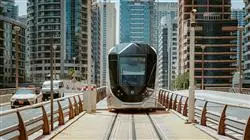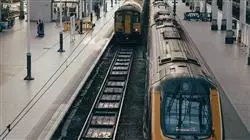University certificate
Scientific endorser

The world's largest faculty of engineering”
Introduction to the Program
It analyzes the new requirements and advances of the Railroad System from a dynamic perspective and is backed by the extensive experience of excellent teaching staff"

The railroad was not born from a spontaneous idea, but after a long process to improve the transportation of coal that began in the 17th century. In those days, the tracks were built with wooden beams that were supported and nailed to sleepers. Over time, this system has evolved and received greater support from state governments. This has favored its path to becoming an environmentally sustainable means of transport, something very much in demand in today's industry. Thus, it has become a fundamental requirement for engineers in this area to continue their academic studies and specialize in a field with a great international projection.
This Professional master’s degree explores the engineering and operation of railroads from a traditional, technical and operational perspective, but taking into account the current international context, which establishes new specific requirements for professionals in this sector. Special emphasis is placed on the new trends and technologies towards which the railroad is moving, in order to increase its technical efficiency and its service to society. Likewise, an analysis of the new safety requirements that are substantially conditioning the design and operations of the Railroad Systems is proposed.
The program is applicable in all geographical areas related to railroads, with a clear international dimension. We have taken into account specific aspects of railroad networks, projects and services that represent an outstanding reference in the railroad field and therefore are of great interest for the student. The Professional master’s degree has been planned in a practical way, so that the contents can be directly applied in the different professional fields of the railroad.
New technologies play an important role in this program. The railroad sector requires professionals who, already having technical competence in the traditional aspects of the sector, are familiar with, and know, the new challenges that the railroad is facing. For this reason, this program incorporates specific modules on research, development and innovation in the sector and on the digital transformation it is undergoing, all of which are key elements in the new strategy to be followed.
With the graphic and practical content, this Professional master’s degree provides students all the knowledge they need in their daily work day"
This Professional master’s degree in Railroad Systems contains the most complete and up-to-date program on the market. The most important features include:
- Improve professional skills in the field of railroad systems
- Update and focus the student's company's strategies in these terms
- Demand new requirements in the technology acquisition processes
- Add value to the technical projects to be developed by student's companies and organizations
- The graphic, schematic, and eminently practical contents with which they are created, provide scientific and practical information on the disciplines that are essential for professional practice
- Practical exercises where the self-assessment process can be carried out to improve learning
- Special emphasis on innovative methodologies
- Theoretical lessons, questions to the expert, debate forums on controversial topics, and individual reflection assignments
- Content that is accessible from any fixed or portable device with an Internet connection
Have access to a program that is applicable in all geographical areas related to railroads, and has a clear international dimension”
The program’s teaching staff includes professionals from sector who contribute their work experience to this training program, as well as renowned specialists from leading societies and prestigious universities.
The multimedia content, developed with the latest educational technology, will provide the professional with situated and contextual learning, i.e., a simulated environment that will provide immersive training programmed to train in real situations.
This program is designed around Problem Based Learning, whereby the professional must try to solve the different professional practice situations that arise during the academic year. For this purpose, the professional will be assisted by an innovative interactive video system created by renowned and experienced experts.
Become a professional in the railroad sector by possessing the technical competencies in the traditional aspects of the sector"

Apply the new concepts of safe design and modifications in the Railroad System in service to your professional field"
Why study at TECH?
TECH is the world’s largest online university. With an impressive catalog of more than 14,000 university programs available in 11 languages, it is positioned as a leader in employability, with a 99% job placement rate. In addition, it relies on an enormous faculty of more than 6,000 professors of the highest international renown.

Study at the world's largest online university and guarantee your professional success. The future starts at TECH”
The world’s best online university according to FORBES
The prestigious Forbes magazine, specialized in business and finance, has highlighted TECH as “the world's best online university” This is what they have recently stated in an article in their digital edition in which they echo the success story of this institution, “thanks to the academic offer it provides, the selection of its teaching staff, and an innovative learning method aimed at educating the professionals of the future”
A revolutionary study method, a cutting-edge faculty and a practical focus: the key to TECH's success.
The most complete study plans on the university scene
TECH offers the most complete study plans on the university scene, with syllabuses that cover fundamental concepts and, at the same time, the main scientific advances in their specific scientific areas. In addition, these programs are continuously being updated to guarantee students the academic vanguard and the most in-demand professional skills. In this way, the university's qualifications provide its graduates with a significant advantage to propel their careers to success.
TECH offers the most comprehensive and intensive study plans on the current university scene.
A world-class teaching staff
TECH's teaching staff is made up of more than 6,000 professors with the highest international recognition. Professors, researchers and top executives of multinational companies, including Isaiah Covington, performance coach of the Boston Celtics; Magda Romanska, principal investigator at Harvard MetaLAB; Ignacio Wistumba, chairman of the department of translational molecular pathology at MD Anderson Cancer Center; and D.W. Pine, creative director of TIME magazine, among others.
Internationally renowned experts, specialized in different branches of Health, Technology, Communication and Business, form part of the TECH faculty.
A unique learning method
TECH is the first university to use Relearning in all its programs. It is the best online learning methodology, accredited with international teaching quality certifications, provided by prestigious educational agencies. In addition, this disruptive educational model is complemented with the “Case Method”, thereby setting up a unique online teaching strategy. Innovative teaching resources are also implemented, including detailed videos, infographics and interactive summaries.
TECH combines Relearning and the Case Method in all its university programs to guarantee excellent theoretical and practical learning, studying whenever and wherever you want.
The world's largest online university
TECH is the world’s largest online university. We are the largest educational institution, with the best and widest online educational catalog, one hundred percent online and covering the vast majority of areas of knowledge. We offer a large selection of our own degrees and accredited online undergraduate and postgraduate degrees. In total, more than 14,000 university degrees, in eleven different languages, make us the largest educational largest in the world.
TECH has the world's most extensive catalog of academic and official programs, available in more than 11 languages.
Google Premier Partner
The American technology giant has awarded TECH the Google Google Premier Partner badge. This award, which is only available to 3% of the world's companies, highlights the efficient, flexible and tailored experience that this university provides to students. The recognition as a Google Premier Partner not only accredits the maximum rigor, performance and investment in TECH's digital infrastructures, but also places this university as one of the world's leading technology companies.
Google has positioned TECH in the top 3% of the world's most important technology companies by awarding it its Google Premier Partner badge.
The official online university of the NBA
TECH is the official online university of the NBA. Thanks to our agreement with the biggest league in basketball, we offer our students exclusive university programs, as well as a wide variety of educational resources focused on the business of the league and other areas of the sports industry. Each program is made up of a uniquely designed syllabus and features exceptional guest hosts: professionals with a distinguished sports background who will offer their expertise on the most relevant topics.
TECH has been selected by the NBA, the world's top basketball league, as its official online university.
The top-rated university by its students
Students have positioned TECH as the world's top-rated university on the main review websites, with a highest rating of 4.9 out of 5, obtained from more than 1,000 reviews. These results consolidate TECH as the benchmark university institution at an international level, reflecting the excellence and positive impact of its educational model.” reflecting the excellence and positive impact of its educational model.”
TECH is the world’s top-rated university by its students.
Leaders in employability
TECH has managed to become the leading university in employability. 99% of its students obtain jobs in the academic field they have studied, within one year of completing any of the university's programs. A similar number achieve immediate career enhancement. All this thanks to a study methodology that bases its effectiveness on the acquisition of practical skills, which are absolutely necessary for professional development.
99% of TECH graduates find a job within a year of completing their studies.
Professional Master's Degree in Railway Systems
. ?
Railway technology has been adapting to the needs of many medium and large cities around the world. Its importance is linked to the existing connection chains between national and transnational borders, where part of the economy of each country is based and policies are built, so that in this way these projects continue to be beneficial in the communication and stability of the variants of this type of infrastructure. Undoubtedly, this transportation network contributes to the needs and energy plans designed in a global and local agenda, which invites the reduction of environmental pollution being this the most environmentally friendly means of mobility. That is why the Professional Master's Degree in Railway Systems TECH focuses on training professionals with the fundamental tools to understand and perform a critical analysis in relation to this enriching technological and industrial field.
Study this Professional Master's Degree in Railway Ordnance online
?
This program is developed over one year and consists of ten modules, in which we delve into the railroad and its engineering in the current context, traction electric power, control, command and signaling (CMS), telecommunications, civil infrastructure, rolling stock, risks and safety, operation, research, development and innovation and the new digital revolution in this system. All of the above was designed with the objectives of deepening the different technical concepts of the sector due to the technological scientific progress, without leaving aside the traditional approaches on which this transport model is based. All this is possible with the methodology used by TECH which is based on e-learning, in which the contents are given in the asynchronous and offline modality, allowing flexibility in the schedule and place of study. In the Professional Master's Degree the students will face multiple simulated cases, based on real situations, so that in this way they can investigate, create one or more hypotheses and finally provide a solution to the problem.







